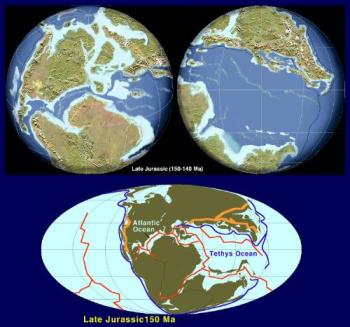some thing about Jurassic age
By masbaaz
@masbaaz (395)
India
December 3, 2006 1:38am CST
Named for the Jura Mountains on the border between France and Switzerland, where rocks of this age were first studied, the Jurassic has become a household word with the success of the movie Jurassic Park. Outside of Hollywood, the Jurassic is still important to us today, both because of its wealth of fossils and because of its economic importance -- the oilfields of the North Sea, for instance, are Jurassic in age.
Great plant-eating dinosaurs roaming the earth, feeding on lush growths of ferns and palm-like cycads and bennettitaleans. . . smaller but vicious carnivores stalking the great herbivores. . . oceans full of fish, squid, and coiled ammonites, plus great ichthyosaurs and long-necked plesiosaurs. . . vertebrates taking to the air, like the pterosaurs and the first birds. . . this was the Jurassic Period, beginning approximately 210 million years ago and lasting for 70 million years of the Mesozoic Era.
1 person likes this
2 responses
@stvasile (7306)
• Romania
30 Jan 07
Ok, that's true. What would you aspect people to respond to this.
I find it very interesting, but I really don't know what more to say...
Maybe that apart from the oil reserves we also have coal deposits from The Jurassic, period known as a typical coal-forming period (like The Carboniferous ant The Neogene periods)...
Or the paleogeographic aspects...
During the early Jurassic, the supercontinent Pangaea broke up into North America, Eurasia and the southern supercontinent Gondwana; the Gulf of Mexico opened in the new rift between North America and what is now Mexico's Yucatan Peninsula. The Jurassic North Atlantic Ocean was relatively narrow, while the South Atlantic did not open until the following Cretaceous Period, when Gondwana itself rifted apart. The Tethys Sea closed, and the Neotethys basin appeared. Climates were warm, with no evidence of glaciation. As in the Triassic, there was apparently no land near either pole, and no extensive ice caps existed.
The Jurassic geological record is good in western Europe, where extensive marine sequences indicate a time when much of the continent was submerged under shallow tropical seas; famous locales include the Jurassic Coast World Heritage Site and the renowned late Jurassic lagerstätten of Holzmaden and Solnhofen. In contrast, the North American Jurassic record is the poorest of the Mesozoic, with few outcrops at the surface. Though the epicontinental Sundance Sea left marine deposits in parts of the northern plains of the United States and Canada during the late Jurassic, most exposed sediments from this period are continental, such as the alluvial deposits of the Morrison Formation.
The first of several massive batholiths were emplaced in the northern Cordillera beginning in the mid-Jurassic, marking the Nevadan orogeny. Important Jurassic exposures are also found in Russia, India, South America, Japan, Australasia, and the United Kingdom.







